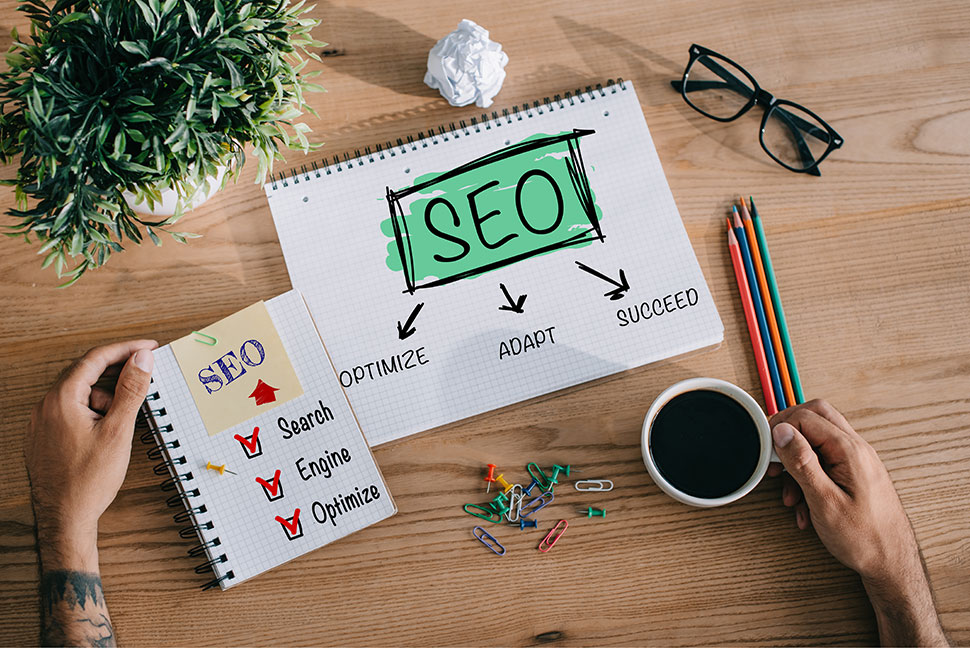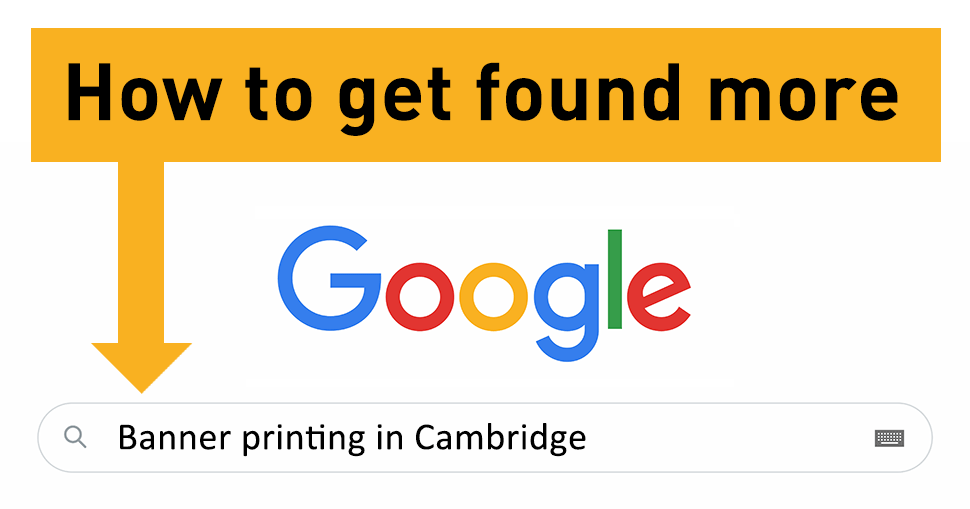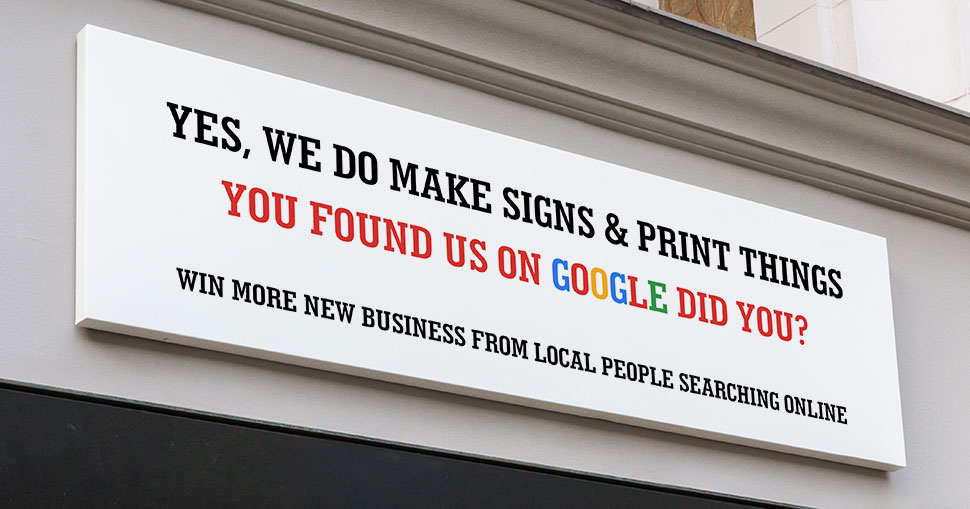While almost all print and signage businesses have some form of online presence, not all are familiar with how they can maximise this offering to attract more customers. LFR takes a closer look at SEO tools and how these solutions can offer a cost-effective and impactful way of driving more traffic to your website.
Further, we’ve included a How To guide that, if actioned, will help you to ensure that any Google search in your local area for a sign or display print business will have your business listed as one of the options. That’s free by the way, it just takes an investment of time, but more on that later.
Given the highly competitive nature of the modern market, simply just having a website is no longer enough for companies operating across the print and signage sectors. While having an attractive and easy-to-navigate website is an absolute must in the modern market, printers need to think beyond this in order to ensure they are being noticed in a busy arena.
The reality of the situation is that the first port of call for customers is Google. Long gone are the days of picking up the Yellow Pages and flicking through to find the printer you need; simply fire up your computer or take your phone at of your pocket, type in what you need on Google, and you are met with a whole array of options, leaving the customer with almost too much choice.
To set out the issue, I did a quick Google search for printers in the town I live – Exmouth in Devon. Simply typing in ‘Exmouth printer’ threw up almost two million results. Exmouth may be the biggest town in Devon, but it is pretty safe to say there aren’t quite that many print companies here.
At the top of the search results, you will find the local companies that are more savvy when it comes to online. Search engine optimisation is an absolute must if you want to appear near the top of the results, rather than tucked away somewhere down the bottom of page four, far away from how long the customer will be willing to scroll.
Link with reputable businesses
For those not familiar with the term, search engine optimisation, or SEO, does what it says on the tin; it helps improve the performance of your website in a search engine, helping to drive more traffic to your site and growing your presence online as a result.
But how do you go about SEO if you are not familiar with this process? There is plenty that print and signage companies can do without being overly online savvy and, perhaps most importantly, without having to spend a great deal.
Firstly, let us look at the subject of backlinks, i.e. when one website links to another with an anchor text. These play a huge role in SEO, so it is incredibly important you get this right.
In the early days of Google, the search engine’s algorithms treated all backlinks the same, and the more you had, the better your rating would be. This could also be boosted by listing your company in a local business directory, with this then automatically linking you to a network of businesses and their websites.
Fast-forward to the present day and things are very different; you now have to be careful with the backlinks you are using as these can impact your ranking.
For example, backlinks to reputable, trusted and well-known websites will help improve your SEO, so if there is the opportunity to link to such a site, grab it with both hands. On the flip side, if you link with bad directories or unreportable sites, this will likely harm your score and see you slip down the pages.
Rather than linking with every man and their website, Google now encourages website owners to create links that are “editorially placed or vouched for by the site’s owner of the page”, otherwise known as ‘natural links’.
The best kind of these links are ‘organic’ backlinks; when someone finds your website, likes what they see and link it to their own content. So, this could be a customer that was particularly pleased with a piece of print you produced and wanted to shout about it – and you – on their own site.

Situation with citations
At the same time, this should not discourage you from linking with reputable business directories, with Google able to recognise legitimate links formed by listing on a directory. Each of these listings acts as a citation and should include your company’s ‘NAP’ – name, address and phone number – with the aim of helping people discover your business.
The good news is that these citations can be managed in house, but the bad news is that they do require a fair amount of work and focus. There are hundreds of local citations that could, in theory, be checked by hand, but there are automated local listing checks you can take advantage of to make this process much easier. For example, Moz Local’s Check Listing tool allows you to check your local business listings across the web for both inclusions and accuracy.
Then there are the different types of local citations, all of which can have a positive impact on your business. The obvious ones for SEO are search engines like Google and Bing, but there are plenty of others to consider.
First, primary data aggregators, with the core platforms here including Foursquare, Data Axle, and Neustar/Localeze, then major directories and important platforms, with businesses able to build a listing on popular social and review-oriented sites such as Facebook and Yelp.
Next, in addition to the major local business data platforms that serve all industries, you can also make use of websites that are specific to a unique industry and geography. This might include sites of professional associations, of which there are plenty in the print and sign markets such as the IPIA for UK print and BSA-UK for signage businesses.
Also consider unstructured citations, which can be built or earned on a host of publications including blogs, news sites, apps, maps and government databases. While these are not specifically structured for the publication of local business listings, they can still act as a reference to a business.
Finally, owned properties. After all, your website is the most authoritative representation of your business data on the internet, so it is incredibly important that all information on the site is accurate and updated on a regular basis to keep the citation reliable.
To put it simply, if you list accurate information across a number of reputable business directories, along with backlinks to your site, then Google will recognise you as a legitimate business and list you higher in search results. If you ensure your business looks reputable and trustworthy, then this will accordingly be reflected in your ranking.

How to get found by new customers
We have established why and how SEO is important to a print or signage company, so where do we go from here? A good place to start would be looking at some of the best, free business directories to use so you can get to work on securing those all-important, reputable backlinks.
Starting with the behemoth, Google and Google My Business. Over one billion people use Google as their main search engine, so it will attract the most traffic, while the Google Maps function will help direct customers to your place of work. Another popular search engine with its own free business directory is Bing, with the Bing Places for Business allowing local business owners to add their listing.
Another leading brand to consider is Facebook, the go-to social media platform for many people in the UK. Again, offering a free service to users, a listing on Facebook will allow consumers to find out more about a company’s location, opening times and services, as well as read reviews from other customers.
Yell, the online form of the much loved and trusted printed Yellow Pages, bills itself as the UK’s leading online business directory. Easily confused with Yell is Yelp, an online social directory that allows consumers to review their favourite local places and businesses.
Another popular source of local business information is 192.com. There is a fair chance that you will already be listed here, but it is best to check if all the information is correct and up to date to ensure customers are being directed to the right places.
FreeIndex has over 250,000 UK business members, 650,000 customer reviews and more than 1.5 million registered users. Completing your business profile on this directory will help your ranking on the site, ensuring you appear higher when consumers are searching for a certain service or product.
Elsewhere, Cyclex operates over 30 directories and claims more than one million visitors every day. It is easy to set up a profile on Cyclex and features include contact details, website address, social information and opening hours, while visitors can also read and write reviews about products and services a business provides.
The UK Small Business Directory showcases smaller companies to the public, while Hotfrog helps pinpoint businesses in a local area, narrowing down the search for consumers and helping to raise awareness of companies in communities.
Business Magnet is similar in that it lists thousands of businesses and suppliers in a local area, with each business link including all key information about the company, while the aptly named My Local Services offers a similar solution plus an online forum for visitors to discuss local companies and their services.
Bizify combines local SEO with information in business directories and social media accounts to help registered companies be found by the people who require their services. There is also the option for customers to review businesses they have worked with on the site.
Opening Times is fairly self-explanatory with its core focus, but also presents visitors with all the key information about each listed business, while Opendi allows users to filter down companies by their location and business type, plus provides the opportunity to leave reviews.
Finally, county council directories serve as a reputable source of information on companies within the local area. Also free of charge, these types of directories could prove extremely useful when seeking new customers in a certain region. You can find your local country council website by clicking here.
If you are thinking big and want to draw attention from outside the UK, then social media could well be the way to go. Alongside Facebook and its free listing, Instagram, another platform owned by the social media giant Meta, offers Instagram for Business and a free way of showcasing your business to a global audience, all illustrated with eye-catching images.
For a more business-focused approach, the LinkedIn Company Directory helps businesses generate leads, drive website traffic and build brand awareness, though this may incur some costs if you are to go down the route of targeted adverts and link conversion.
All of the above will help you towards your end goal, which is ultimately driving more traffic to your website and generating more business from online. It might take some time and you might not see results overnight, but by following some of the guidance set out here and doing your own market research to find out the best route for your business, you will see a difference and experience the benefits in the long term.
By Rob Fletcher





